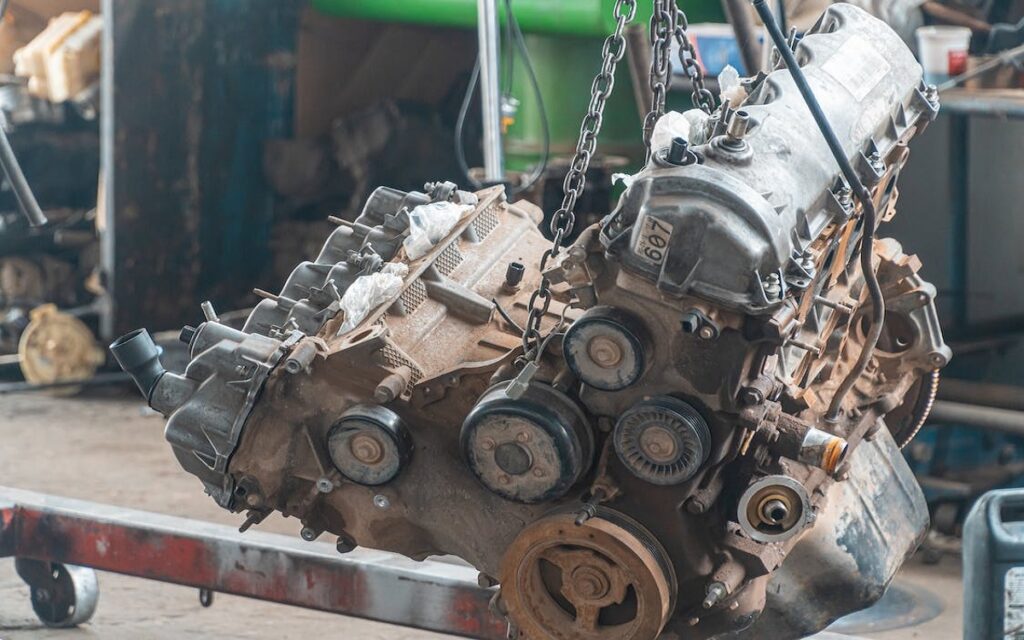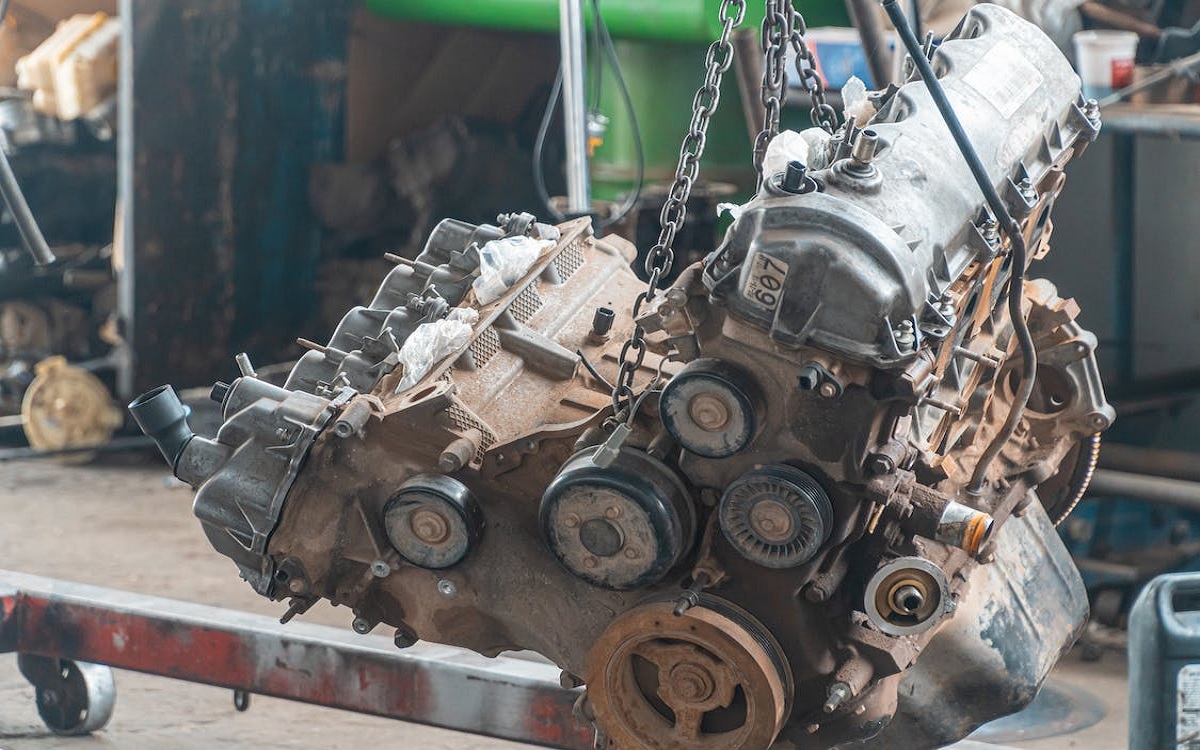The timing belt is a crucial component in a vehicle’s engine, responsible for synchronizing the rotation between the camshaft and crankshaft. This synchronization allows the engine’s valves to open and close at precisely the right time during the combustion process. When the timing belt becomes worn or damaged, it can have severe consequences for your engine. Being attentive to the signs of timing belt failure and having repairs done promptly is essential to avoid extensive engine repairs.
Recent Released: Best Automobile Storage Facilities In USA
What is a Timing Belt?
A timing belt, also called a camshaft belt, is a reinforced rubber belt located on the front of the engine. It has teeth that fit into grooves on the end of the crankshaft and camshaft pulleys. As the crankshaft rotates, it drives the timing belt, which in turn rotates the camshaft. This allows the valves to open and close in sync with the pistons moving up and down in the cylinders. The synchronization enabled by the timing belt is key to efficient fuel combustion and engine performance.

Timing belts are found in most modern engines with overhead camshafts versus older engine designs with camshafts located in the engine block. Timing chains are also used on some engines instead of belts and have the benefit of longer service life as they are located inside the engine and bathed in lubricating oil. However, timing belts are often quieter in operation.
Why is Proper Timing Belt Function Important?
Maintaining the proper timing of valve operation is critical for smooth engine performance and operation.
Here are some key reasons why the timing belt is such an integral component:
- Allows valves to open and close at precisely the right moment during the 4-stroke combustion cycle. This supports complete fuel combustion and proper engine timing.
- Prevents piston and valve contact. The timing belt keeps the camshaft and crankshaft perfectly aligned to prevent collisions between pistons and open valves, which can significantly damage the engine.
- Enables effective exhaust and intake cycles. Proper timing enables precise coordination of the opening and closing of intake and exhaust valves. This ensures efficient intake of the air/fuel mixture and exhaust of spent gases.
- Supports engine balance and smoothness. The timed operation of the valves contributes to overall balanced engine function and reduces vibration.
- Failure causes serious engine damage. If the timing belt breaks or slips, the camshaft and crankshaft synchronization is disrupted. This can cause bent valves, damage to pistons and cylinder heads, requiring expensive repairs.
10 Common Symptoms of a Bad Timing Belt
Catching the signs of a failing timing belt early is the best way to avoid extensive engine damage. Here are 10 symptoms to look out for:
- Unusual engine noises – If you hear unusual rattling, tapping, or squealing noises from the front area of the engine, it could indicate issues with the timing belt and should be inspected immediately.
- Difficulty starting – Problems turning over the engine to start, particularly on cold mornings, can be caused by timing belt wear impacting the synchronization between components.
- Oil leaks – The timing belt area is sealed, so leaks of oil or coolant in front of the engine could indicate damage or wear to the timing belt or related seals.
- Check engine light – The check engine light may illuminate due to error codes related to camshaft/crankshaft position sensor issues caused by timing belt problems.
- Smoke from exhaust – Excessive exhaust smoke, especially at startup, may point to timing issues leading to incomplete combustion.
- Overheating engine – A worn timing belt can disrupt ignition timing, causing the engine to overheat.
- Lack of power – Insufficient valve timing from a damaged belt reduces engine power output. Acceleration may suffer noticeably.
- Poor gas mileage – Incorrect valve timing caused by a faulty timing belt reduces combustion efficiency, hurting fuel economy.
- Battery light – A loose timing belt may not properly turn the alternator, causing the battery to lose charge and the warning light to activate.
- Visible damage signs – Carefully inspect the timing belt if accessible. Look for signs of cracks, glazing, fraying threads, and missing teeth indicating replacement is needed.
When to Replace the Timing Belt

Most vehicle manufacturers recommend replacing the timing belt at regular intervals between 60,000-100,000 miles.
However, the operating conditions, age, and type of vehicle can impact the replacement interval needed. Here are some factors to consider:
- Mileage – Stick closely to the mileage interval specified in your owner’s manual, such as 60,000 or 90,000 miles. Going past this recommendation risks belt failure.
- Age – Even if the mileage is low, belts over 6-10 years old are prone to deterioration and should be replaced.
- Operating conditions – Frequent short trips, extreme temperatures, towing, and stop-and-go driving can accelerate belt wear and require earlier replacement.
- Inspection – Have a certified mechanic inspect the belt if you notice any symptoms of wear and replace if needed. Cracks, missing teeth, or glazing indicate replacement time.
- Maintenance history – Review maintenance records to determine if the timing belt has been replaced according to recommended intervals.
Following the manufacturer’s replacement intervals, keeping an eye out for wear symptoms, and having regular inspections done are the best ways to maximize timing belt life and avoid costly repairs from failure.
Cost to Replace a Timing Belt
Replacing a timing belt is an involved repair that requires specialized tools and knowledge. The typical timing belt replacement cost ranges from $300 to $1100 depending on the vehicle’s make and model.
The components and labor involved in the replacement impact the overall cost:
- Timing belt kit – $50-$300 for the belt, tensioner pulley, and any accessory belts that require replacement at the same time. High-end performance vehicles tend to be more expensive.
- Water pump – $150-$500 for the replacement water pump recommended any time the belt is replaced. Some kits include the pump.
- Labor – 4-8 hours of labor at $100 per hour is common, making labor the majority of the overall cost. High-end imports may have higher labor rates.
- Miscellaneous parts – Additional $50-$200 may be needed for tensioners, pulleys, seals, and other small components recommended to be replaced along with the belt.
- Engine tuning – Resetting and tuning the engine’s timing and fuel mapping may add another 1-2 hours of labor to the cost.
While the bill for a timing belt replacement can be high, it is much less expensive than a damaged engine from a broken belt. Replacing it at the recommended intervals is far more cost effective.
Timing Belt vs Timing Chain
While both serve essentially the same purpose in the engine, there are some key differences between timing belts and timing chains:
- Material – Timing belts are made of rubber reinforced with tough composite materials. Timing chains are metal, usually steel.
- Location – Timing belts are located on the outside of the engine. Timing chains are internally housed within the engine.
- Maintenance – Timing belts require regular replacement. Chains are designed to last the lifetime of the engine in most cases.
- Lubrication – Belts are not lubricated, while chains are lubricated by engine oil, reducing wear.
- Noise – Chains are typically noisier during operation than belts, although modern designs have reduced this.
- Failure – A timing chain stretching over time can cause timing issues, but usually will not leave you stranded like an abruptly broken belt.
- Cost – Belt replacement is less expensive than chain replacement in most cases. Replacing a chain often requires significant disassembly.
Both designs have their merits and choice depends on the vehicle make and model. Pay close attention to the recommended replacement and inspection intervals for whichever system your engine has to avoid problems.
Signs of Timing Chain Stretch
For engines equipped with a timing chain rather than a belt, the chain stretching over time can indicate a need for replacement.
Here are some signs of a stretched timing chain:
- Rattling noise from engine front at startup
- Vibration felt throughout the vehicle
- Oil leaks at the front of the engine
- Loose or rattling sprockets
- Illuminated check engine light
- Timing chain rubbing against cover
- Engine misfiring or loss of power
Have a certified mechanic inspect the timing chain if any of these symptoms occur. If excessive stretch is confirmed, chain replacement will be needed to avoid further damage.
Fixing a Bad Timing Belt or Chain
If your timing belt or chain is found to be damaged or excessively worn during inspection, replacement is needed:
- Find a certified mechanic -Timing system replacement requires special expertise and tools. Find an ASE certified mechanic experienced in belt/chain replacement for your particular vehicle.
- Use OEM components – Genuine OEM belt or chain components from the vehicle manufacturer are recommended for your car.
American Local Garage stays informed on how different driving patterns impact timing belt lifespans. Be sure to inform them if your vehicle routinely faces harsh conditions so they can tailor maintenance recommendations accordingly. More frequent timing belt inspections and earlier replacement may be warranted to counteract excessive wear.
Timing Belt Symptoms Case Study
In some cases, a bad timing belt manifests as dimming or flickering headlights when idling or driving. This indicates an charging system issue caused by a compromised belt. Loose timing belt teeth prevent the alternator belt from spinning properly to recharge the battery.
Dimming Headlights
American Local Garage technicians are experts at spotting and correcting charging system issues related to damaged accessory belts. First, they test battery voltage and the alternator output using specialized diagnostic equipment. If voltage readings are abnormal and the timing belt is worn out, they will replace both belts to restore your battery charging system.
| Symptom | Potential Cause | Solution |
|---|---|---|
| Unusual engine noises | Loose or damaged timing belt | Replace timing belt & components |
| Difficulty starting | Compromised timing belt | Replace timing belt, diagnose other issues |
| Smoke from exhaust | Damaged valves or gaskets from bad timing belt | Replace timing belt, valves, gaskets as needed |
| Oil leaks (front) | Bent valves from timing issues | Replace timing belt, diagnose & address leaks |
| Dimming lights | Bad alternator belt | Check charging system, replace timing & alternator belts |
6. Visible Damage on Timing Belt
Physically inspecting the timing belt when the engine is cold can reveal obvious damage like frayed edges, cracks, missing teeth or other visible defects. These signs indicate the timing belt has become too worn or dry to operate properly. Driving with damaged timing belt risks complete failure.
The mechanics at American Local Garage will perform a thorough visual and physical examination of your timing belt if you suspect an issue. If any cracks, fraying, missing sections or abnormal wear is present, they will provide a replacement to restore engine synchronization and prevent breakdowns.
High Mileage
In most vehicles, the timing belt should be replaced every 60,000-100,000 miles based on the manufacturer’s recommendations. Routinely driving past this replacement interval greatly increases the chances of abrupt timing belt failure. Preventative timing belt replacement is vital.
As your trusted local garage, American Local Garage tracks your vehicle’s mileage and service history reminders. They will advise you when it is time to replace the timing belt based on your make and model’s recommendations. This proactive maintenance prevents expensive repairs and keeps your vehicle running smoothly.
Conclusion
Ignoring symptoms of timing belt issues can lead to extensive repairs, roadside breakdowns and costly engine rebuilds. American Local Garage has the cutting-edge tools, technology and expertise to accurately detect and fix all common timing belt problems. Schedule an inspection as soon as possible if you suspect timing belt failure. Our professional technicians will get your car repaired and back on the road reliably.


Leave a Reply